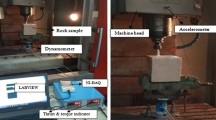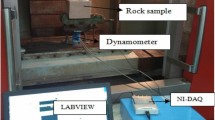Abstract
The main purpose of the study is to develop a general prediction model and to investigate the relationships between sound level produced during drilling and physical properties such as uniaxial compressive strength, tensile strength and percentage porosity of sedimentary rocks. The results were evaluated using the multiple regression analysis taking into account the interaction effects of various predictor variables. Predictor variables selected for the multiple regression model are drill bit diameter, drill bit speed, penetration rate and equivalent sound level produced during rotary drilling (L eq). The constructed models were checked using various prediction performance indices. Consequently, it is possible to say that the constructed models can be used for practical purposes.





Similar content being viewed by others
References
Alvarez GM, Babuska R (1999) Fuzzy model for the prediction of unconfined compressive strength of rock samples. Int J Rock Mech Min Sci 36:339–349
Bradford IDR, Fuller J, Thompson PJ, Walsgrove TR (1998) Benefits of assessing the solids production risk in a North Sea reservoir using elastoplastic modeling. SPE/ISRM Eurock ‘98 held in Trondheim, Norway, pp 261–269
Brown ET (ed) (1981) Rock characterization testing and monitoring. In: International society for rock mechanics (ISRM) suggested methods, Pergamon, Oxford
Cargill JS, Shakoor A (1990) Evaluation of empirical methods for measuring the uniaxial compressive strength of rock. Int J Rock Mech Min Sci Geomech Abst 27(6):495–503
Carmichael RS (1982) Handbook of physical properties of rocks, vol II. CRC Press, Boca Raton
Drake R (2004) Bench drilling techniques and equipment selection manual. Ingersol Rand, Italy
Ersoy A, Waller MD (1995) Prediction of drill-bit performance using multivariable linear regression analysis. Trans Inst Min Metall A 104:101–114
Finol J, Guo YK, **g XD (2001) A rule based fuzzy model for the prediction of petrophysical rock parameters. J Pet Sci Eng 29:97–113
Gokceoglu C (2002) A fuzzy triangular chart to predict the uniaxial compressive strength of Ankara agglomerates from their petrographic composition. Eng Geo 66:39–51
Horsrud P (2001) Estimating mechanical properties of shale from empirical correlations. SPE Drill Complet 16:68–73
Jimeno CL, Jimeno EL, Carcedo FJA (1995) Drilling and blasting of rocks. Balkema, Rotterdam
Jizba D (1991) Mechanical and acoustical properties of sandstones and shales. PhD thesis, Stanford University
Kahraman S (1999) Rotary and percussive drilling prediction using regression analysis. Int J Rock Mech Min Sci 36:981–989
Kahraman S (2001) Evaluation of simple methods for assessing the uniaxial compressive strength of rock. Int J Rock Mech Min Sci 38:981–994
Kahraman S, Balci C, Yazici S, Bilgin N (2000) Prediction of the penetration rate of rotary blast hole drilling using a new drillability index. Int J Rock Mech Min Sci 37:729–743
Katz O, Reches Z, Roegiers JC (2000) Evaluation of mechanical rock properties using a Schmidt hammer. Int J Rock Mech Min Sci 37:723–728
Kwasniewski M (1989) Laws of brittle failure and of B–D transition in sandstones. In: Maury V, Fourmaintraux D (eds) Rock at great depth. Balkema, Brookfield, pp 45–58
Lama RD, Vutukuri VS (1978) Handbook on mechanical properties of rocks, vol II. Trans Tech Publications, Clausthal, Germany
Miklusova V, Usalova L, Ivanicova L, Krepelka F (2006) Acoustic signal—new feature in monitoring of rock disintegration process. Contrib geophys geodesy SAS 36(SI 6SGK):125–133
Osanloo M (1998) Drilling methods. Sadra, Teheran
Palchik V (1999) Influence of porosity and elastic modulus on uniaxial compressive strength in soft brittle porous sandstones. Rock Mech Rock Eng 32(4):303–309
Rajesh KB, Vardhan H, Govindaraj M (2010) Estimating rock properties using sound level during drilling: field investigation. Int J Min Mineral Eng 2(3):169–184
Rao KUM, Misra B (1998) Principles of rock drilling. Balkema, Rotterdam
Serradj T (1996) Method of assessment of rock drillability incorporating the Protodyakonov index. Trans Inst Min Metall A 105:175–179
Singh VK, Singh DP (1993) Correlation between point load index and compressive strength for quartzite rocks. Geotech Geol Eng 11(4):269–272
Singh SP, Ladouceur M, Rouhi F (1998) Sources, implication and control of blasthole deviation. In: Proceedings of the 7th international symposium on mine planning and equipment selection, Balkema, Rotterdam
Thuro K (1997) Drillability prediction—geological influences in hard rack drill and blast tunneling. Geol Rundsch 86:426–438
Tugrul A, Zarif IH (1999) Correlation of mineralogical and textural characteristics with engineering properties of selected granitic rocks from Turkey. Eng Geol 51:303–317
Vardhan H, Adhikari GR, Govindaraj M (2009) Estimating rock properties using sound level during drilling. Int J Rock Mech Min Sci 46(3):604–612
Wong TF, David C, Zhu W (1997) The transition from brittle faulting to cataclastic flow in porous sandstones: mechanical deformation. J Geophys Res 102:3009–3025
Yilmaz I, Yuksek AG (2008) An example of artificial neural network application for indirect estimation of rock parameters. Rock Mech Rock Eng 41(5):781–795
Yilmaz I, Yuksek AG (2009) Prediction of the strength and elasticity modulus of gypsum using multiple regression, ANN, ANFIS models and their comparison. Int J Rock Mech Min Sci 46(4):803–810
Zborovjan M, Lesso I, Dorcak L (2003) Acoustic identification of rocks during drilling process. J Acta Montanistica Slovaca 8(4):91–93
Zhang L (2005) Engineering properties of rocks. Elsevier, Amsterdam
Author information
Authors and Affiliations
Corresponding author
Rights and permissions
About this article
Cite this article
Rajesh Kumar, B., Vardhan, H. & Govindaraj, M. Prediction of Uniaxial Compressive Strength, Tensile Strength and Porosity of Sedimentary Rocks Using Sound Level Produced During Rotary Drilling. Rock Mech Rock Eng 44, 613–620 (2011). https://doi.org/10.1007/s00603-011-0160-7
Received:
Accepted:
Published:
Issue Date:
DOI: https://doi.org/10.1007/s00603-011-0160-7




